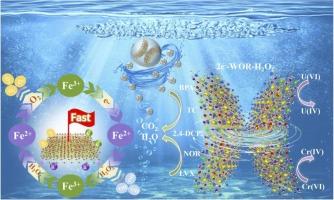Synergistic Oxidation and Reduction of Complex Pollutants in Wastewater using a Self-cycling Piezo-photocatalytic Fenton System
IF 11.3
1区 环境科学与生态学
Q1 ENGINEERING, ENVIRONMENTAL
引用次数: 0
Abstract
Simultaneous organic pollutant oxidation and heavy metal ion reduction may enhance ocean and medical wastewater treatment. Here a self-cycling piezo-photocatalytic Fenton (SPF) system was developed using an Na-Sm bimetal-doped layered ferroelectric perovskite SrBi2Nb2O9 (NS-SBNO) and Fe2+ ions. The experimental results and density functional theory calculations demonstrated that bimetal doping induced an enhanced internal electric field, improving electron–hole pair separation and transmission. NS-SBNO exhibited increased adsorption energy and electron transfer capacity of H2O, leading to H2O2 production at 497 μmol g−1 h−1 through a two-electron water oxidation reaction without any sacrificial reagent. Furthermore, compared with traditional Fenton systems, the SPF system afforded higher Fe2+/Fe3+ interconversion efficiency and hydroxyl and superoxide radical yields, highlighting the system’s excellent redox capabilities. The SPF system also demonstrated enhanced oxidation and reduction of complex pollutants in wastewater [e.g., BPA, TC, 2, 4-DCP, NOR, LVX, U(VI), and Cr(VI)], demonstrating promising practical applicability.

自循环压电光催化Fenton系统协同氧化和还原废水中复杂污染物
有机污染物的氧化和重金属离子的还原可以提高海洋和医疗废水的处理效果。本文利用Na-Sm双金属掺杂层状铁电钙钛矿SrBi2Nb2O9 (NS-SBNO)和Fe2+离子,开发了自循环压电光催化Fenton (SPF)体系。实验结果和密度泛函理论计算表明,双金属掺杂诱导了内部电场的增强,改善了电子-空穴对的分离和传输。NS-SBNO提高了对水的吸附能和电子转移能力,在没有任何牺牲试剂的情况下,通过双电子水氧化反应生成497 μmol g−1 h−1的H2O2。此外,与传统Fenton系统相比,SPF系统具有更高的Fe2+/Fe3+相互转化效率,羟基和超氧自由基产量,突出了系统出色的氧化还原能力。SPF系统还显示了对废水中复杂污染物(如BPA、TC、2,4 - dcp、NOR、LVX、U(VI)和Cr(VI))的氧化和还原能力,显示了良好的实用性。
本文章由计算机程序翻译,如有差异,请以英文原文为准。
求助全文
约1分钟内获得全文
求助全文
来源期刊

Journal of Hazardous Materials
工程技术-工程:环境
CiteScore
25.40
自引率
5.90%
发文量
3059
审稿时长
58 days
期刊介绍:
The Journal of Hazardous Materials serves as a global platform for promoting cutting-edge research in the field of Environmental Science and Engineering. Our publication features a wide range of articles, including full-length research papers, review articles, and perspectives, with the aim of enhancing our understanding of the dangers and risks associated with various materials concerning public health and the environment. It is important to note that the term "environmental contaminants" refers specifically to substances that pose hazardous effects through contamination, while excluding those that do not have such impacts on the environment or human health. Moreover, we emphasize the distinction between wastes and hazardous materials in order to provide further clarity on the scope of the journal. We have a keen interest in exploring specific compounds and microbial agents that have adverse effects on the environment.
 求助内容:
求助内容: 应助结果提醒方式:
应助结果提醒方式:


